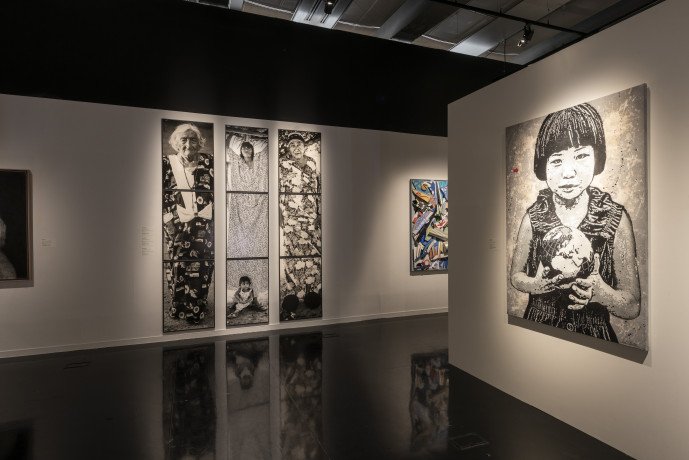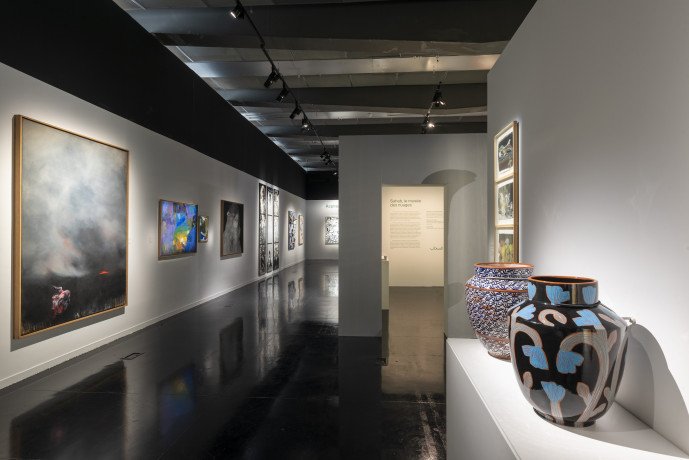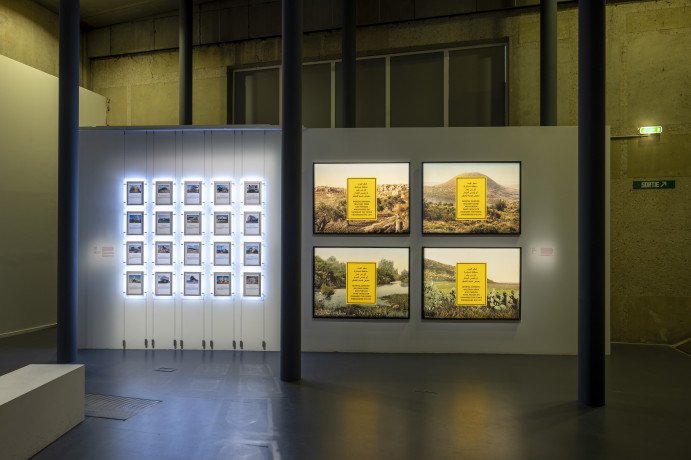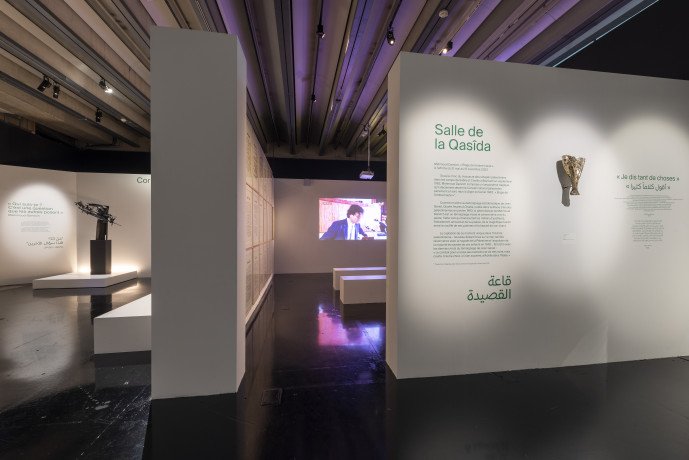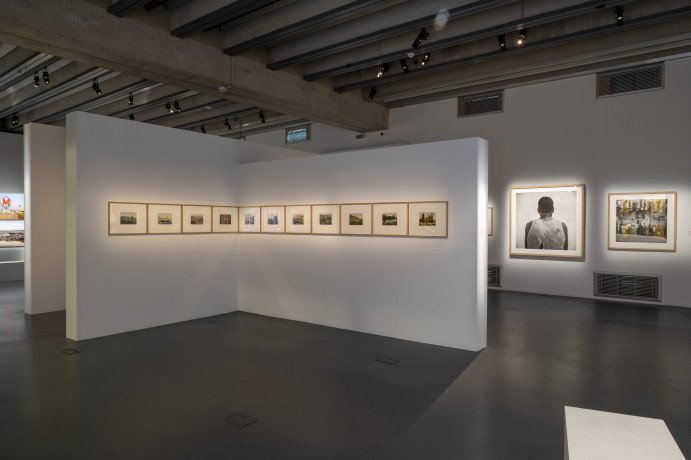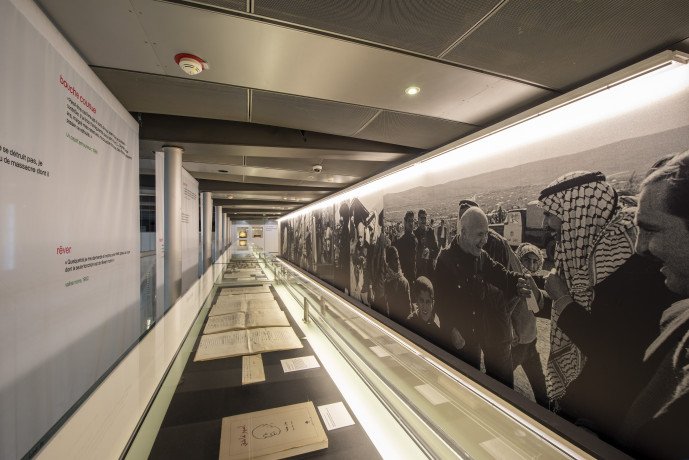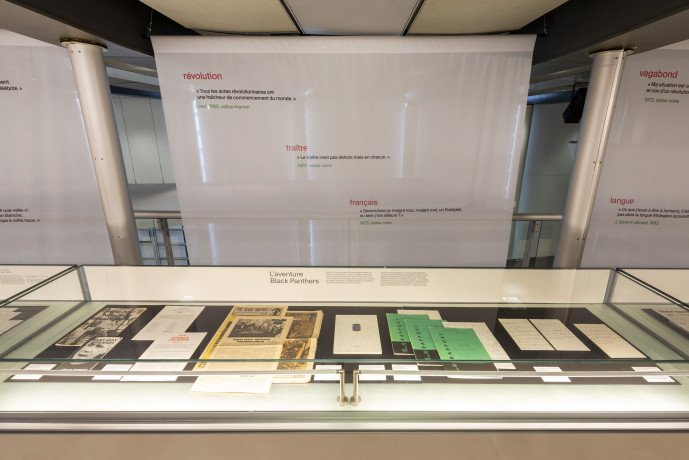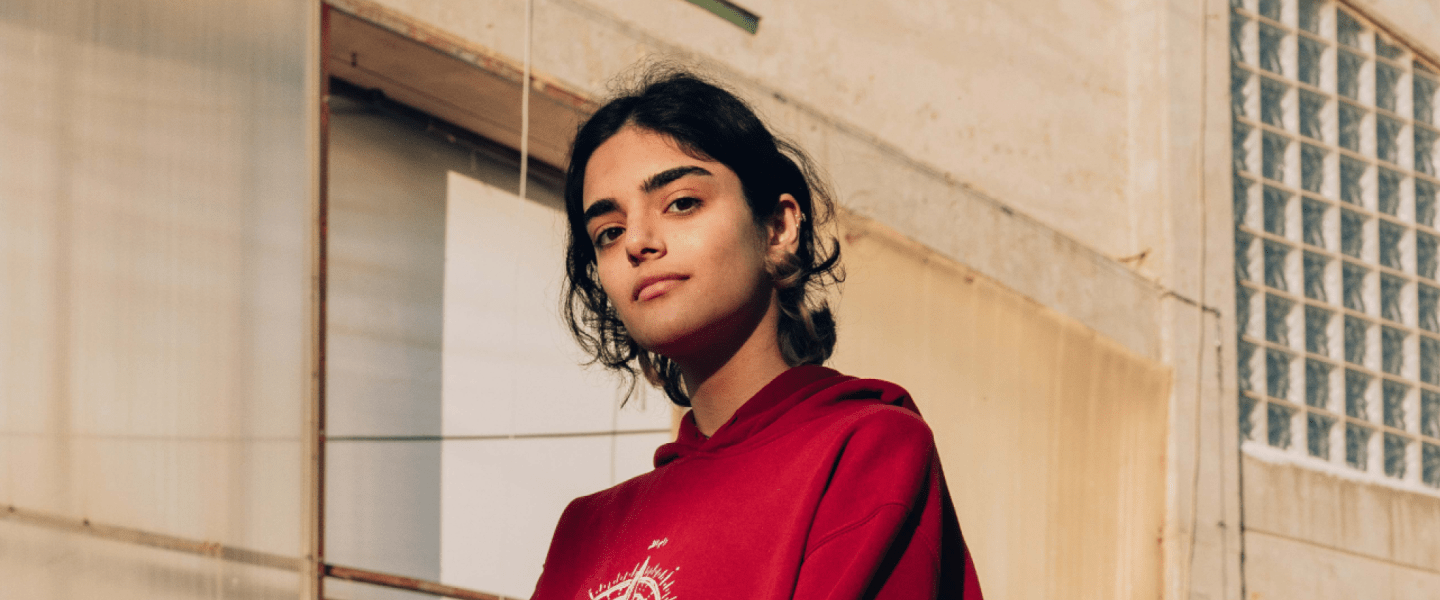
Ce que la Palestine apporte au monde / What Palestine Brings to the World
Exposition prête à voyager
Available on tour
> Institut du monde arabe 31 mai - 31 décembre 2023 / May 31 - December 31, 2023
> Institut français de Tunisie 24 mai - 28 juin 2024 / May 24 - June 28, 2024
L'Institut du monde arabe a choisi de donner à voir l’élan et l’irréductible vitalité de la création palestinienne, qu’elle s’élabore dans les territoires ou dans l’exil. Approches muséales plurielles, dialogue photographique entre la Terre sainte « inventée » des orientalistes et celle des contemporains, exposition des précieuses archives palestiniennes de Jean Genet… : c’est à un subtil et intense parcours de correspondances visuelles et de sujets qu'invite l'exposition.
Under the beautiful title ‘What Palestine Brings to the World’, the Institut du Monde Arabe is aiming to shine a light on Palestine in all its artistic, poetic and cultural beauty. This title is also a challenge to the world, through a happy reversal: Palestine is very much a contributor to humanity through its talents, its positive energy and its dreams.
CONTACT
Mario Choueiry
Responsable des expositions itinérantes
Touring Exhibitions
Tel: +33 (1) 40 51 38 80
Une présentation de la Palestine sous ses mille et une couleurs, intellectuelles, créatives et combatives.
Le Journal des arts, juin 2023
Depuis 2016, l’IMA abrite en ses murs la collection du futur Musée national d’art moderne et contemporain de la Palestine, une « collection solidaire » de quelque 400 œuvres constituée de dons d’artistes, réunie à l’initiative d’Elias Sanbar, écrivain et ancien ambassadeur de la Palestine auprès de l’Unesco, et coordonnée par l’artiste Ernest Pignon Ernest.
En 2023, l’Institut a choisi de donner à voir l’effervescence culturelle que la Palestine ne cesse de révéler et d’entretenir avec un cycle de trois expositions mettant en avant les artistes modernes et contemporains palestiniens, dans un dialogue avec leurs homologues du monde arabe et la scène internationale. Une programmation culturelle variée – concerts, colloques, ateliers, cinéma, rencontres littéraires –, a rythmé cet événement.
Les Palestiniens et Palestiniennes en leurs musées
Artistes exposés :Hamed Abdalla, Jef Aérosol, Amadaldin Al Tayeb, Jean-Michel Alberola, François-Marie Antonioz, Mehdi Bahmed, Vincent Barré, François Bazin-Didaud, Serge Boué-Kovacs, Mustapha Boutadjine, Jacques Cadet, Luc Chery, Bruce Clarke, Alexis Cordesse, Henri Cueco, Marinette Cueco, Noël Dolla, Bruno Fert, Anne-Marie Filaire, Noriko Fuse, Garrigo Beatriz, Christian Guémy alias C215, Anabell Guerrero, Stéphane Herbelin, Mohamed Joha, Valérie Jouve, Ahmad Kaddour,Robert Lapoujade, Julio Le Parc, Patrick Loste,Ivan Messac, May Murad, Chantal Petit, Pierson Françoise, Ernest Pignon-Ernest, Samir Salameh, Antonio Segui, Didier Stephant, Hervé Télémaque, Marc Trivier, Jo Vargas, Vladimir Velickovic, Marko Velk, Gérard Voisin, Jan Voss, Fadi Yazigi, Stephan Zaubitzer et Hani Zurob.
De février à avril 2023, une nouvelle génération d’artistes nés entre 1990 et 2000 – Adam Al-Mghari, Ahmed Abunada, Bayan Abu Nahla, Amal Al-Nakhala, Rawan Murad, Sobhi Qouta, Samar Sharaf, Hamada Alkept, Fouad Khater, Hala Alabassi, Hazem Alzomar, Jehad Al-Ghoul, Aboud Nasser, Enas Rayyan – se sont réunis pour réaliser la première œuvre de ce musée-en-devenir. L'expérience de réalité augmentée a été conçue spécialement pour l'IMA par un des membres du collectif Hawaf, l'artiste et ingénieur Andres Burbano.
Quant à la collection moderne et contemporaine du musée de l’IMA, elle inclut des œuvres d’artistes, hommes et femmes, palestiniens et du monde arabe témoignant et dénonçant le sort fait au peuple palestinien depuis la Nakba en 1948.
Artistes exposés : Mohammed Al Hawajri,Nabil Anani,Tayseer Barakat, Kamal Boullata, Chaouki Choukini, Paul Guiragossian, Abdul Rahman Katanani, Soleiman Mansour, Ahmed Nawash et Amer Shomali.
Les œuvres exposées sont relayées par le souffle du poème de Mahmoud Darwich, « Éloge de l’ombre haute », qu’il déclama devant le parlement palestinien en exil à Alger, en février 1983.
Images de Palestine : une Terre sainte ? Une terre habitée !
Les deux registres d’images de cette exposition, prises au XIXe siècle et de nos jours, partagent un medium commun, la photographie, et une réalité commune, la Palestine. Pourtant, tout distingue ces deux ensembles par-delà leur « différence d’âge ». Ce sont deux modes du voir, deux conceptions de la Palestine. Mis en dialogue, ces deux regards montrent chacun à leur manière, la quête des Palestiniens vers la réappropriation, par l’image, de leur propre récit.
Le premier regard, orientaliste, aura de lourdes conséquences des décennies durant, faisant de la Palestine une Terre sainte, figée dans le temps, prisonnière d’un passé jamais révolu, promise à une quête infinie d’une gloire ancienne, en attente de ses « sauveurs « légitimes », missionnaires et colons, pour revenir à la vie. Cet ensemble réunit une trentaine de vues – paysages, scènes de genre et portraits – tirées selon le procédé Photochrom, qui permettait de coloriser des photographies en noir et blanc.
Le second regard est celui de 14 photographes contemporains palestiniens – Mohamed Abusal, Shady Alassar, Rehaf Al-Batniji, Taysir Batniji, Raed Bawayah, Tanya Habjouqa, Rula Halawani, Maen Hammad, Hazem Harb, Safaa Khatib, Eman Mohammed, Amer Nasser, Raeda Saadeh,Steve Sabella – qui livrent des images « habitées » de leur terre.
Les valises de Jean Genet
Quinze jours avant sa mort, en avril 1986, Jean Genet remet à son avocat Roland Dumas deux valises de manuscrits. Que contiennent-elles de si précieux ? Toute sa vie. À première vue, un fouillis de lettres, de factures d’hôtel, de notes sur tout et sur rien, sur la prison, l’écriture, l’homosexualité ou le cinéma. Mais elles abritent également les traces vives d’un compagnonnage de seize années avec les Black Panthers et les Palestiniens.
De cet itinéraire qui va du silence à l’œuvre symphonique, les valises donnent à lire les étapes, des premiers tâtonnements jusqu’aux reflets de sa rencontre avec le peuple palestinien, devenue sa préoccupation majeure et l’objet central de son livre testamentaire.
Outre les valises, sont également montrés le manuscrit et le tapuscrit des textes de Jean Genet qui commentent en toute liberté les photographies que Bruno Barbey (agence Magnum) a prises, « avec l’œil d’un témoin objectif », en Palestine entre 1969 et février 1971 ; ils ont été publiés dans le magazine de l’image Zoom, en août 1971.
Jean Genet n’a pas manqué de contribuer à la Revue d’études palestiniennes, notamment avec un puissant témoignage après les massacres dans les camps de réfugiés de Sabra et Chatila, en 1982. La Revue lui a rendu un vibrant hommage dans sa livraison d’avril 1997. Des épreuves de la couverture des numéros dans lesquels l’auteur est intervenu, illustrée par des artistes de renom – Alberto Giacometti, Etel Adnan, Kamal Boullata, Dia Azzawi – complètent l’accrochage.
Exposition coproduite par l’Institut du monde arabe et l’Institut Mémoires de l’édition contemporaine
Palestinians in their museums; the voice of Mahmoud Darwich
Since 2016, the IMA has housed the collection of the Palestinian National Museum of Modern and Contemporary Art, a collection of solidarity made up of gifts from artists from the five continents, who were asked to choose from among their works what they wished Palestinians to see. The selection of works on display, reflecting the diversity of trends ranging from abstract art to hyperrealism, creates a convergence of questions common to artists and their future public: what does it mean to be human, in one’s own body and identity, and what does it mean to live, for oneself and with or among others? Existing also means having aspirations, and individual or collective dreams, vehicles both for an expectation veering between hope and uncertainty and for a movement aimed at achieving them or fleeing an impossible everyday life.
Within this display, the Sahab Museum’s project (sahab means ‘cloud’ in Arabic) explores how to treat the past, act in the present and imagine a future in Palestine. This project is supported by the Hawaf collective (hawaf means ‘margins’ in Arabic), initiated by three visual artists, Mohamed Abusal in Gaza, Mohamed Bourouissa in Paris, Salman Nawati in Sweden – and an architect – Sondos El-Nakhala in Gaza. The aim is to rebuild a community in Gaza, which will be a stakeholder in the construction of the Sahab Museum through workshops linking artists from various disciplines and inhabitants. Using virtual reality technology and the creation of digital works of art around a Palestinian heritage, the museum will thus be accessible to the public in Palestine and throughout the world.
Images of Palestine: A Holy Land? An inhabited land!
The two categories of images in this exhibition, those taken in the 19th century and those of today, share a common medium, photography, and a common reality, Palestine. Yet above and beyond their difference in age, these contrasting ensembles are different and distinct in every way. Arranged in a dialogue, they offer two ways of seeing, two perspectives, two approaches of Palestine.
The first, Orientalist perspective would have major consequences for decades, making Palestine a Holy Land, frozen in time, the prisoner of an ever-present past, doomed to an infinite search for old glory, waiting for ‘legitimate’ saviours, missionaries and settlers, in order to come back to life. This ensemble consists of around thirty views featuring landscapes, genre scenes and portraits, using the Photochrom process, patented in 1889 by the Swiss Orelle Füssli.
The second, contemporary perspective – one century later – reveals the vital energy of creators. It highlights their inventiveness imbued with humour and self-derision, enabling them through the strength of their sensibility to overcome the weight of their everyday lives. In Gaza, in the West Bank and in Jerusalem, from historic Palestine and from the diaspora, they link art, the public space and its reappropriation through the body that inhabits it as much as it performs it. The selection brings together a variety of photographers born between the 1960s and the 1990s: Shady Alassar, Mohamed Abusal, Rehaf Al Batniji, Taysir Batniji, Raed Bawayeh, Tanya Habjouqa, Rula Halawani, Maen Hammad, Hazem Harb, Safaa Khatib, Eman Mohamed, Amer Nasser, Steve Sabella, Raeda Saadeh, whose works were all executed after 2010.
Intended as an ode to Palestine’s contemporary creativity, this exhibition brings together artists who offer a new conception of their territory and propose offbeat, passionate visions of everyday life under the occupation.
Jean Genet's suitcases
Two weeks before his death, in April 1986, Jean Genet gave his lawyer Roland Dumas two suitcases of manuscripts. What did they contain that was so precious? His entire life.
At first sight, it was a hotchpotch of letters, hotel bills, notes about everything and nothing, prison, writing, homosexuality and cinema. But they also contained the live traces of a fellowship of sixteen years with the Black Panthers and the Palestinians.
And they concealed yet another story: the story of a writer who, at the age of 50, had given up literature. So what was he doing with his life? And what does a writer who no longer writes write?
The suitcases provided an answer to this question: despite of himself and in spite of his vow of silence and his ‘sealed lips’, Genet was writing. He was writing on everything that came to hand – envelope, hotel letter paper, pieces of torn newspaper. Everywhere, he was scribbling his life. And one day, mysteriously, out of these thousands of scattered notes emerged the manuscript of a work that would combine, unlike any other, literature and politics, and interlink the great adventure of the Black Panthers and the feddayin with the account of the life of a former child of the welfare system.
A month after Jean Genet’s death, Un captif amoureux was published, the greatest book written by a Western author about the Palestinians’ struggle.
This secret journey illuminates this exhibition through manuscripts hitherto completely unknown. The suitcases allow us to read the principal stages of this itinerary that goes from silence to the symphonic work, from the first fumbling attempts to the reflections on his first encounter with the Palestinian people, which had become his major preoccupation and the central object of his testamentary book.
Also on display, in addition to the suitcases, are the manuscript and typescript of Jean Genet’s texts, which comment freely on the photographs that Bruno Barbey (Magnum agency) took, ‘with the eye of an objective witness’, in Palestine between February 1969 and February 1971. These texts anticipate certain passages from Un captif amoureux.
Jean Genet contributed to the Revue d’études palestiniennes, in particular with a powerful account following the massacres in the Sabra and Chatila refugee camps, in 1982. The Revue paid vibrant tribute to him in its April 1997 edition. Prints of the cover of the issues the author contributed to, illustrated by renowned artists – Alberto Giacometti, Etel Adnan, Kamal Boullata, Dia Azzawi – supplement the display.
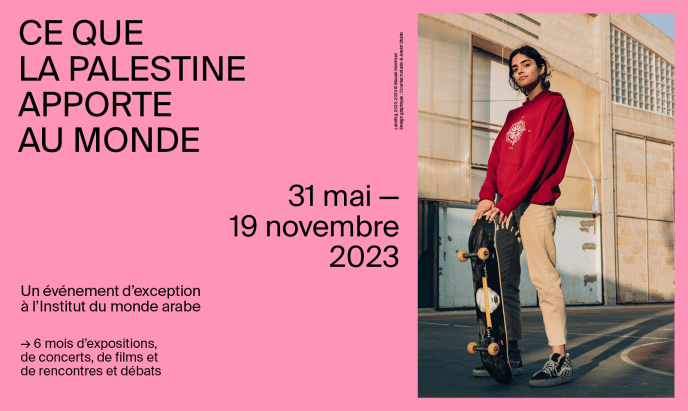
COMMISSARIAT GENERAL
Elias Sanbar
Historien, poète et essayiste palestinien, ancien ambassadeur de la Palestine auprès de l'Unesco

